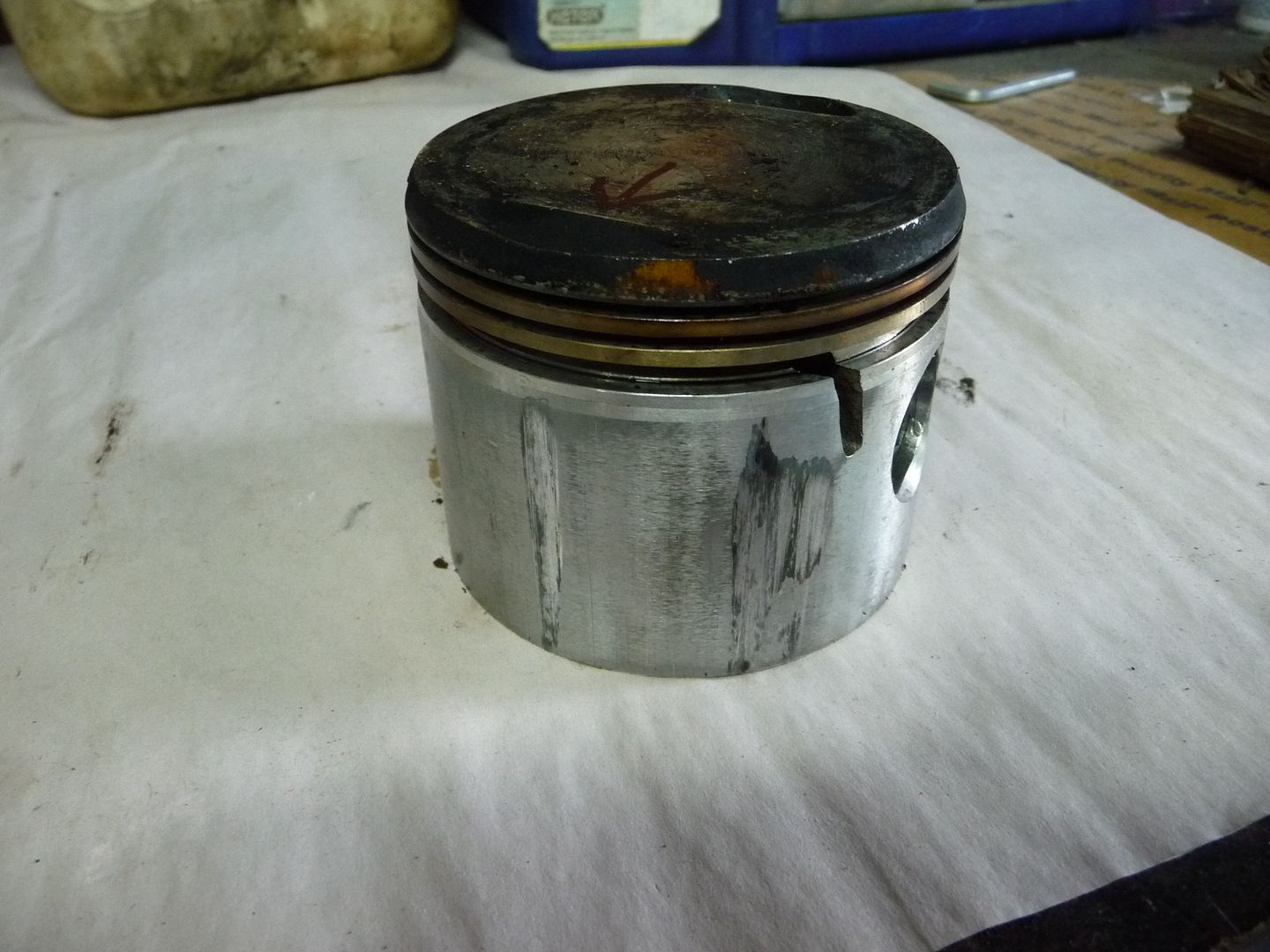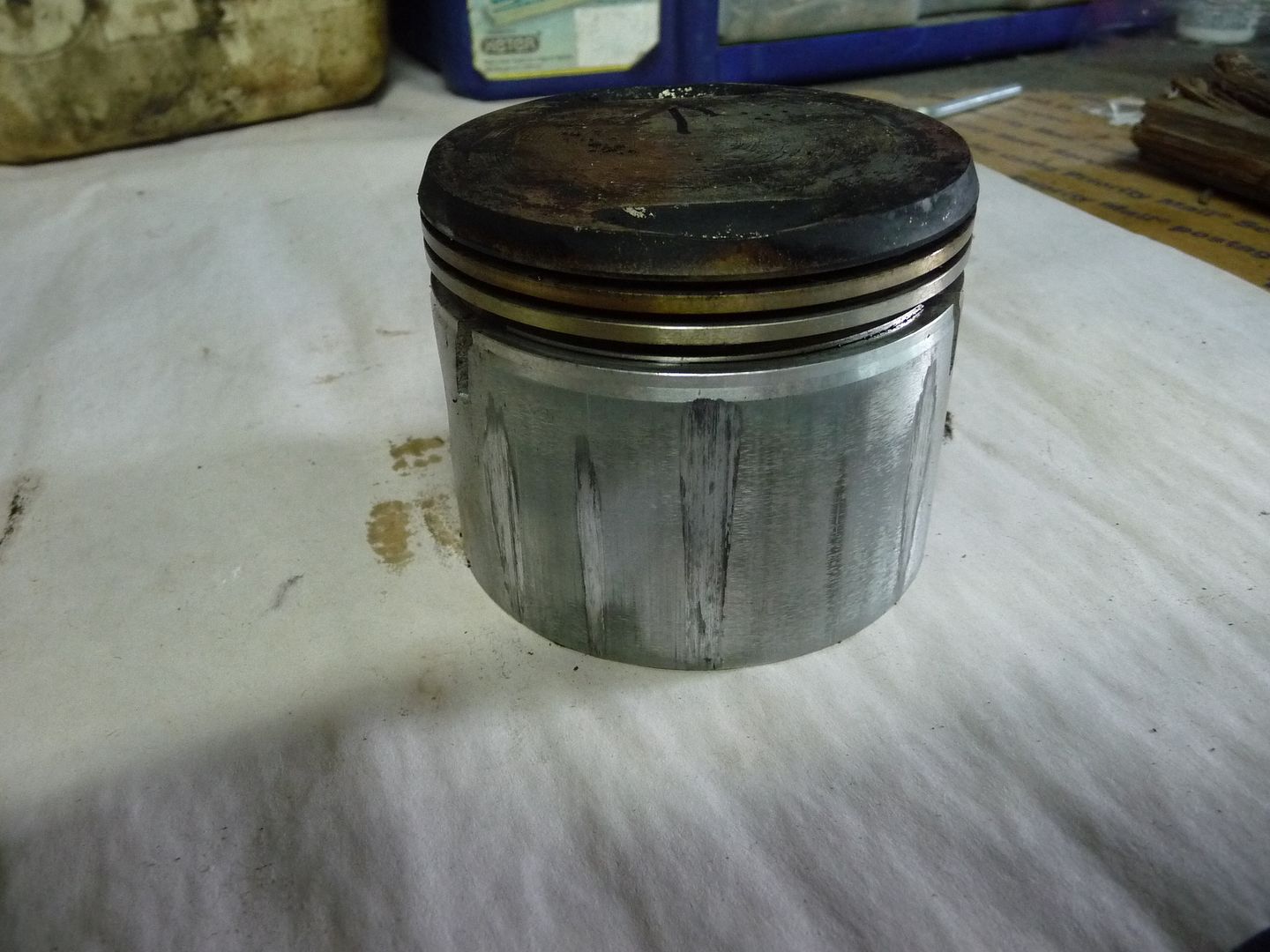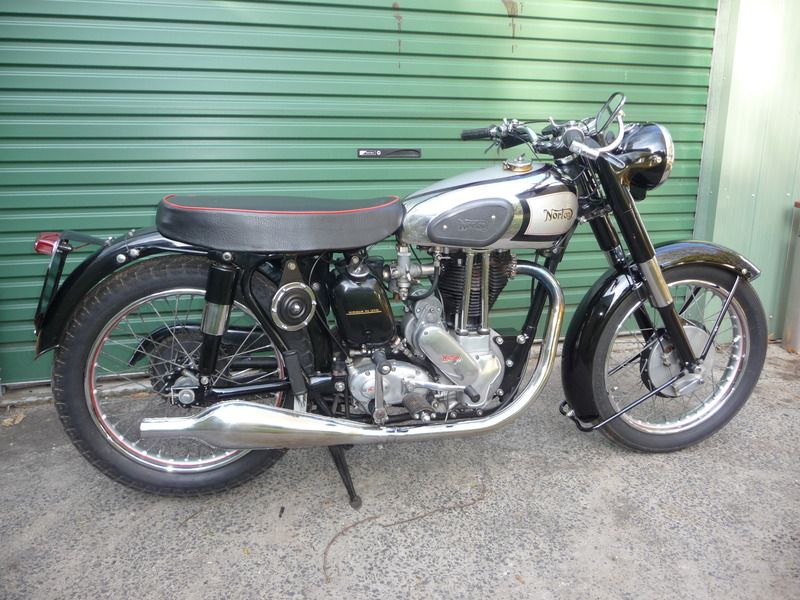My first query after rejoining the NOC after about 25 years away.
I'm recommissioning a 54 ES2 I restored 30 years back but was lost to me for 15 years until I bought it back recently. It has sat for at least 7 years unridden.
Lifting the barrel revealed this damage to a Hepolite +60 piston.
Front
Rear
Skirt clearance seems to be around 6 thou measured with feeler gauges and the top ring has a gap of 12-13 thou at various points in the bore. Can anyone hazard a guess as to what caused this? It could have been any time since first start I guess. I don't wish for a repeat with a new piston.
Thanks
Chris Haywood
Australia
This happened to me (on a…
- Log in to post comments
This looks like a "multi-p…
This looks like a "multi-point" seizure which occurs when the piston out grows the bore size with heat expansion when running. You say this had 6 thou of clearance so should have been OK.
Obviously the hotter the piston becomes the greater it will expand so you have to check things that will make the piston run hotter such as
1) Incorrect ignition timing....either too advanced or too retarded.
2) Too weak a mixture strength. Your piston top looks looks a little scorched in the centre perhaps. Sometimes running at medium speeds with the mid range carburation too lean (Too low a needle setting can cause this). Another thing that can occur is that you have a fuel starvation simply by running out of petrol when riding hard this creates a sudden leap of temperature that seizes the piston.*
3)Insufficient lubrication, either oil pump weak or revving engine too fast before oil has thinned (oil grade too thick)... the thick oil cannot fling out in sufficient quantity from the big end to cool and lubricate the piston.
Note....you may well be able to smooth this old piston by careful use of wet and dry but keep the amount of metal you take off uniform all the way round so the basic shape or profile is not changed. It can then be used in another re-bored barrel to match the piston to give the correct clearance....maybe in the original barrel but slight posibilty of piston slap, but it doesn't look too damaged so could well be OK....Les
* A piston "seizure" very often does not lock the engine, sometimes it just tightens and you hardly notice it, sometimes you can just wind the power on a bit more thinking the bike is slowing due to a gradient or wind. The most likely time is when you are running-in a rebuilt engine and push it too hard with too little mileage clocked up.
- Log in to post comments
Hi David, the bore looks p…
Hi David, the bore looks pretty good, a bit glazed with some small marks that can't be felt so I'm hopeful it will measure up and a hone and new piston will suffice.
Chris
- Log in to post comments
If the piston has no other…
If the piston has no other damage, nothing wrong with carefully easing thescoured high spots down using a millsaw file. A very light hone of the bore to freshen it up, then fit a new set of rings should all be that is necessary to put the engine back in service. Measure the skirt clearance at right angles to the gudgeon pin, .oo6" minimum clearance should be OK, but, going by the seize marks, that piston appears to be not cam ground.
- Log in to post comments
I would rather use a fine…
I would rather use a fine toothed file than wet and dry. Wet and dry has the disadvantage of leaving tiny bits of carborundum embedded in the soft alloy of the piston which is not really what you want. I would certainly try a gentle bore hone and cleaning up the piston before going for a rebore. Les is spot on with his advice about timing and mixture. With present-day relatively low octane petrol, it is important to err on the side of rich rather than weak mixture and also consider retarding the ignition timing a couple of degrees.
- Log in to post comments
Not too long ago, a simila…
Not too long ago, a similar thread to this one raised some interesting discussion about piston clearances and the likely causes of seizures.
Use the search site (above left) to checkout the thread ............. ES2 Engine specification needs.
Also..... this following link comes from the Franks Book re Norton Singles maintenance.
- Log in to post comments
So, Phil, according to EM…
So, Phil, according to EM Franks it looks like you must check with a loose piston without any rings since the clearance is bigger at the top than the bottom of the skirt?
I did some calculations on theoretical changes in clearances but the problem I encountered was not knowing exactly what temperature to assume for the barrel, and what for the piston. And then I found from literature searches that different proportions of silicon in the aluminium alloy give different expansion rates. And how can we be sure that today's pistons have the same silicon content as the originals?
Les Howard's remark about too small a bore is supported by http://www.mmec.net/diagnostic.htm,
but the piston top does look as if the bike was ridden some distance before the problem!
- Log in to post comments
Hi all, I've found these…
Hi all,
I've found these replies really interesting.
As for the piston crown it was generally covered in a sheet of carbon which I cleaned off in the main to see if the piston was still the +60 Hepolite. There seems to be a lot of oil coming through the exhaust valve but I'm yet to disassemble this to see what the guides are like. To me it doesn't look as if there was an issue with the rings - no blowby marks etc, but I'd take your advice on this.
Of course it is next to impossible to time when this seizure might have happened. During my 15 year first ownership it ran very well and sometimes was ridden fastish for long periods (big distances to rallies etc). It seemed to fly, but never had excessive compression as felt on the kickstarter. I don't ever recall a "tightening" of the motor. Of course anything could have happened without my noticing, and in the time since then.
There seems no internal sign of oil starvation.
During a long ride years back the rocker oil feed line fractured and when i stopped the motor the exhaust valve seat dropped into the bore in peices as the motor cooled. Not sure if lack of rocker oil would get the top end so hot to seize but leave the rockers etc still in good condition.
When I dismantled the carb recently the needle was on the richest setting, maybe a result of the new owner chasing a lean mixture. About that time I sold it I'd moved from 3000 ft to sea level so that may have affected jetting which was as per the book. Also the tank has gone fairly rusty inside so maybe rust may be clogging the jets. Not had a close look at the carb bits yet.
While the cost of a new piston isn't an issue I'm thinking seriously of doing as advised by yourselves and others in dressing the piston, and installing new rings, with a hone. Needless to say I'd be extra careful with monitoring it when it finally runs again. If things go pear shaped its not a big job getting the top end off and ES2.
Again thanks for your responses.
Chris
- Log in to post comments
I thought I'd add a pictu…
I thought I'd add a picture or two of the patient.
As found
Now, at the end of its second 30 years.
Cheers
Chris
- Log in to post comments
The classic seizure eviden…
The classic seizure evidence is the 4 corner seize marks on the piston, 2 each side of the pin on both sides, the thickness of the material being higher at this point it expands more due to the heat and so seizes there and not on the skirt faces. So looking at the pics there is something going on other than heat unless inside the piston there is extra material behind the seize marks.
- Log in to post comments
I would clean it up with a…
I would clean it up with a fine file ,piston clearance is not excessive ,its possible the barrel may tighten low down,a check on bore clearance top to bottom,and look for other reasons for overheating.
- Log in to post comments
Hi Chris, I had just the s…
Hi Chris,
I had just the same problem with my mid 50s 19S. After about 30 minutes running the bike would seize up, but would free off after a short time. When I stripped it down,I found a previous owner had fitted a Vincent piston. The barrel was bored to 82mm+060" which is just over 83.5mm and the piston had been turned down from it's standard 84mm to fit. As Paul Knapp suggested, this had simply been turned down on a lathe and was cylindrical. Have you measured your barrel accurately, because you may find it is not +060" oversize and the piston has been turned down as mine was. If this is the case, you can relieve the sides of the piston with hand tools and you need about 10 thou. onEACH side and the existing contact areas on the front and back should be about2" across and blended at the sides to give the cam ground profile which allows for expansion/distortion. Also check the ring grooves are deep enough. Please let us know how you get on with it.
Regards, Richard.
- Log in to post comments
Its definitely a 79mm +60…
Its definitely a 79mm +60 Hepolite piston because its what I sourced had fitted 30 years ago.
Its been an interesting investigation and I've learnt a few things. I took the head (which needs new valves and guides) plus the piston and barrel to my old time engineering works to be assessed. Firstly the piston isn't cam ground - its round. Frank didn't like that bit..but suggested he could relieve the sides as suggested. He wasn't particularly concerned by the scuff marks
Upon further measurement it was found that the bottom of the skirt was 5 thou distorted inwards - so the clearance on the base was 10 thou+. I hadn't picked that up. Yes we could still use it but it would slap when cold in his opinion. The bore was only worn 2 thou at worst.
Given the work that needed to be done and the condition of the piston we both agreed that I'd be better sourcing a new piston. I guess I'll source one from RGM as I need to place a parts order and they have most of what I want. Any other suggestions?
RGM also have higher compression pistons to fit the later ES2 alloy head models but which MAY fit in the iron engines. They suggest checking the deck height with what I have to see if there is sufficient clearance. Given the limited use the bike will receive, and performance not being a priority, I'm favouring staying with standard comp. Any experiences with the higher comp pistons in iron engines?
Also thanks all or the input on this topic.
Chris
- Log in to post comments
Advice given from my frien…
Advice given from my friendly engineer (ex F1 engines, now restoring motorcycle engines) is don't go above 7.5:1 if you can avoid it these days. His main concern is present day fuels which are of much lower octane rating than we were used to 40 years ago. There are plenty of people riding bikes with higher compression ratios quite happily, but I would certainly avoid anything higher than that if possible. Interestingly, racing Rudges are generally pretty low compression ratios but can still shift.
Another aside. My son was hammering his 88 on the Autobahn 2 up in high summer on cheapest petrol. Both piston crowns collapsed and one broke through and then a con rod snapped. Saving a few cents on petrol cost him a lot in the long run. And guess who ended up doing the rebuild?
- Log in to post comments
With due deference to your…
With due deference to your friend, in the UK all fuel during the 1940's was 72 octane, in the 1950's when Chris's bike was built, the levels were typically 75 or 92. Later we had 95 and the magical 100 octane. Few bikes needed the 100 octane but it was a macho thing so we paid the extra.
So modern 95 and 98 octane fuels are not so different from those available ( in Octane RatingTerms) from those available in those days.
- Log in to post comments
Hi Chris. lubrication has…
Hi Chris. lubrication has already been mentioned but perhaps the oil tap was left off at some stage who knows. with a bike built to that standard i personally would have a liner fitted and go for standard piston setup. Baz
- Log in to post comments
Many 500 Rudges run with 8…
Many 500 Rudges run with 8 to10 thou clearance to avoid the dreaded sieze up, and as Gordon says they did not need high comp to perform well. Mine flies . I suspect the 88 had too much advance or weak running . Easy enough for that to happen ,I recently found tap and carb restricted by liner bits ,no wonder it was running hot. Iron motors do run hot and its well worth a dyno check on the mixture at the different throttle phases. Probably best to ditch that slotted skirt piston.
- Log in to post comments








This happened to me (on a twin) on a long uphill incline when one carb needle was (carelessly) too low so it ran lean on one side and began to nip up. I look forward to other comments...
ps if the bore has marks, I'd suggest they might be aluminium and removable with caustic soda and thus avoid an unnecessary re-bore. Again, other comments from experts might assist - just a suggestion to not re-bore prematurely. I did, and have regretted it ever since.